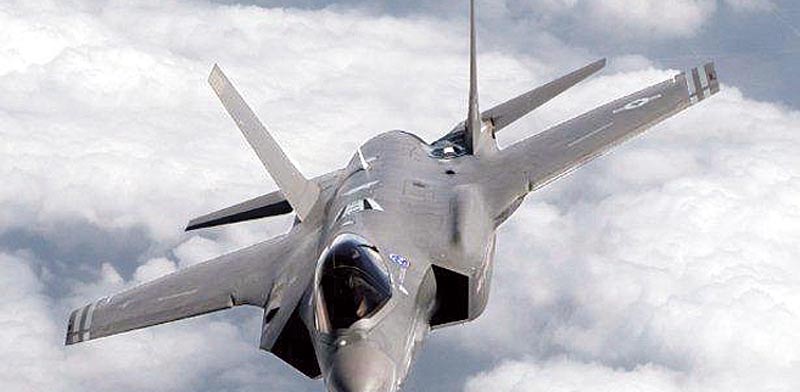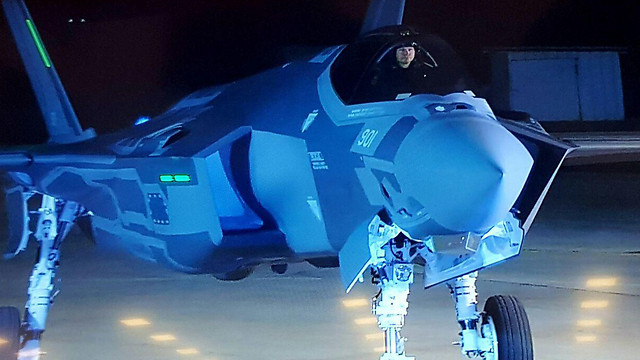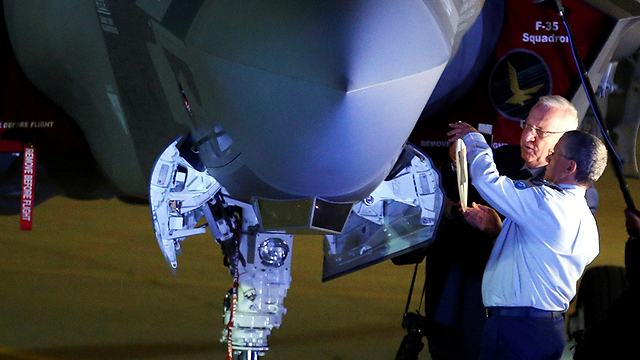Israel's F-35s to have unique secret components
4 Dec, 2016 10:40
Yuval Azulai
Lockheed Martin Israel CE Joshua Shani tells "Globes" about Israel's newest fighter aircraft.
Of the 33 F-35 stealth fighter planes purchased by Israel, the first two will be delivered in three weeks, landing at Nevatim Air Base in southern Israel. Another round of purchases of this advanced, expensive, and controversial fighter is already around the corner. A decision is likely in the coming weeks, with the security cabinet being asked to approve the Ministry of Defense plan to buy 17 more planes.
The first 33 planes were purchased in two series: the first for $2.75 billion and the second for $2.82 billion, including infrastructure, parts, and training simulators.
"33 warplanes is an impossible number," Lockheed Martin Israel CE Brigadier General (ret.) Joshua Shani, who led the development and production plan for the advanced aircraft, told "Globes". "33 are too many for one squadron and two few for two squadrons. The cabinet previously decided to buy 33 planes with an option for 17 more, which will make it possible to maintain two squadrons, and now they have to exercise the option. Minister of Defense Avigdor Liberman notified us that that the defense establishment wants to exercise the option, and this requires cabinet approval. We got the impression that the matter has reached the home stretch."
"Globes": How long will it be before Israel has two such squadrons of 25 planes each?
Shani: "I estimate that delivery of 50 planes can be completed by 2022. The time table can also be brought forward, with delivery being completed by 2021. The money is already there; it's included in the new $38 billion program of US military aid to Israel over the coming decade. Lockheed Martin will step up the pace of production in order to bring forward the delivery of the planes to Israel."
Other than the US, Israel will be the first country to have an operational squadron of F-35s, despite not having been part of the consortium of countries that participated in the development of the expensive plane and financed it. Furthermore, the US contacted Israel when the plan for the aircraft was just beginning and offered it a senior partnership in the ambitious venture, but the Ministry of Defense said thank you, but no thank you. Such a partnership would have involved a huge $200 million investment, and in Israel, there is always something to do with such money when defense is involved. Israel joined the program only at a later stage as an observer, if only to make requests later, and it did so.
How did it happen that countries made huge investments with Israel looking over their shoulders, and Israel got the planes first?
Shani laughs: "Because we're the most impertinent people around. Everything we do is based on impertinence, and that's the case here. We used our elbows to push in again and again, and then we did it some more. There are also our security needs, which are well-known to the US and all the other nice member countries in the project. They realized that Israel really needed this plane."
Maybe it is because selling arms to the IDF is the best sales promotion, or maybe it is because it will be easy for Lockheed Martin to sell these planes around the world around the world after the Israeli air force, which bombed the nuclear reactor in Iraq, destroyed the antiaircraft batteries in the Bekaa Valley in Lebanon, and flew to Entebbe, found the F-35capable of meeting its challenges.
"There's no doubt that selling to Israel has added value, but let's be realistic - it has waned with the years. Israel was once the first country to shoot down MIGs with F-16s. Once, there were dogfights. Today, there are several other wars besides ours. The Israel Air Force's prestige is intact, but against whom has the Air Force fought in recent years? It's gaining almost no operational experience with modern planes. What we did was special once, but that's no longer the case. Today the Russians are attacking, the US is attacking, the Dutch are attacking, and NATO forces are attacking more than Israel, so this balance has changed; it doesn't carry the weight it once did. Something has receded. Nevertheless, the fact that Israel did join the program for the plane at a later stage encouraged those countries that decided to buy the planes at a time when there were arguments and opposition."
A third squadron?
The 17 additional planes that Israel stands to order soon from Lockheed Martin are not the end of the prolonged and intensive saga between the Air Force and the Ministry of Defense and the world's largest arms firm. Lockheed Martin hopes that Israel will want a third squadron of stealth fighters, which will eventually give it a total of 75 F-35s. Incidentally, if it is decided to purchase a third squadron of stealth fighters, these may be the version of the plane with short takeoffs and vertical landings.
According to Shani, Prime Minister Benjamin Netanyahu is very interested in such a squadron, which will provide a solution for a scenario in which Air Force bases are bombarded by thousands of rockets and missiles, damaging runways and the Air Force's ability to function.
While Israel paid $122 million for each aircraft in its first two rounds of F-35 purchases, the third will cost less per aircraft. The US Air Force is currently paying $80-85 million per plane. It is unclear whether this is the price that Israel will pay, and Lockheed Martin is unwilling to provide exact figures. Shani says, "There will be a significant drop in price, and the price per plane will in any case be less than $100 million."
Why is the US Air Force paying less?
"Because the US Air Force doesn't put into the plane what Israel wants to put in it."
What Israel wants to put in this plane is a story in itself. The US did not want to hear about the plans of the Israeli air force to do to the F-35 what it does to every airplane it buys: replacement of the original systems with systems made by Israeli defense companies, all of them secret, in order to adapt the planes' performance to the IDF's needs.
"There was a very long and difficult persuasion process between the Israeli defense establishment and Air Force and the US," Shani says. "At first, they said to Israel, 'This is the plane, this is what it does, don't bother us.' With time, however, they realized that Israel doesn't buy an airplane like that; it wants its own special systems that no one else knows about. They slowly started bending in the right direction. They softened up, and we're already at a point at which all the Israeli requests have been accepted: all the electronic warfare, command and control, and communications systems installed in the plane are Israeli-made."
So the Israeli F-35 and the US F-35 are substantially different?
"'Substantially different' is an exaggeration, but yes, the Israeli plane is better for fulfilling the needs of the Israel Air Force, because the US doesn't have the secret systems installed on the Israeli version, such as an internal communications system between the planes and air control. The US has its own good systems, but they are different. Israel always wanted its own independent electronic warfare systems; if a new Russian missile is brought to the region, these systems can change the capabilities of its planes within a short time and adapt them to a new threat in the area. It takes the US months to make such changes, and we don't always have this amount of time."
A wave of criticism
The Air Force's plan for procuring the advanced plans has drawn withering criticism over the years, which has increased in recent months. This debate, incidentally, is not confined to Israel. Doubts about the readiness of the planes and their true capabilities led to public discussions in other countries planning to buy them, such as Australia, Canada, and the US, of course. "Every new plane entering the picture is criticized like that," Shani says. "We still remember the terrible fuss about development of the F-16. They also asked 'Who needs this?' then. A new airplane always attracts criticism from people who like saying 'no.' Why? Because saying 'no' is always easier than saying 'yes.' There was a big crisis at the time with the F-15, and even with the F-4 Phantom, but there was much less noise."
What happened this time?
"What happened was that there had never been a single aircraft in the Western world that was going to get all the business from everyone for 40 years. Up until now, they divided models and types of planes used by the various branches of the US armed forces between the companies. In this case, for the first time, they didn't divide the work among many companies. The question was whether Boeing or Lockheed Martin would take the plan. Incidentally, the fact that we got the plan surprised us all. We didn't believe that we'd get a giant $400 billion project; we assumed that they'd eventually go for some kind of combined solution that would satisfy both Boeing and Lockheed Martin. As soon as one Western company won the whole pot, all the others were totally opposed. How do you express opposition? You leak fabrications to the media."
What fabrications? Last March, US Department of Defense director of operation test and evaluation Dr. Michael Gilmore appeared before the US Congress and listed more than 930 failures in the plane. He asserted that the F-35's fighting ability was limited, and that the weapon system was not ready.
"So what?," Shani says dismissively. "Most of these failures were corrected long before he presented them to Congress. One of the failures he listed was that the plane could only fly three missions a day. Today, it can fly eight missions a day. There are always problems in this difficult process, and we always solve them. The fact is that 200 of these planes are already flying now, 180 of them in the US, and they have completed over 80,000 flying hours. You have to take things in proportion. A senior general in the Israeli air force once told me that the more Congressional reports were issued about problems in the plane, the more calm and confident he was, because it meant that the faults were being discovered and corrected. What's bad about that? It means that there is an entire system of strong and responsible control. Today, you have 10 Western powers continuing their cooperation with this plan. Like you, everyone reads those reports brought to Congress, and they still believe in the plane. Are they all stupid?"
The wave of criticism about the stealth fighter's supposedly limited capabilities and its un-readiness to perform the promised missions, combined with its astronomical price, NIS 500 million for one plane, is far from naive. Shani says, "In Israel, they made an awful noise about those reports, completely out of proportion to other countries. In this case, I can point my finger at the place from which the poison came, and I do mean poison."
Did someone spread this "poison," as you call it, in an attempt to thwart the procurement of the stealth fighters and so that another plane made by another firm would be chosen?
"That's a nice possibility, and if not to buy another airplane, then to use this money for other things. With this money, you can buy a lot of other things, such as new refueling planes, maybe 20,000 APCs, helicopters, and many other things. It's legitimate to want this money, but they shouldn't lie, and there were many lies here, but I think it's over now. I'm already immune to criticism like this. I was more sensitive at first."
The criticism did not even omit the F-35's definitive feature - the stealth capability that enables it to attack targets without being detected.
"Yes, it's amazingly stealthy. Simply amazing," Shani responds to the criticisms. "I was in the US, and I met with several senior Israel Air Force pilots who went there for special training in flying the aircraft. We met half an hour after they finished an operational training mission with the F-35 on a simulator. They told me that it's impossible, there is no such plane, and believe me, these guys know planes. They fly F-15s and F-16s, and they're experienced. Their eyes sparkled. One of them told me something I can't get out of my head: 'This plane isn't fair to the enemy. It doesn't give him a chance.' That's so right. It's so stealthy, so sophisticated, and so easy to operate. Such an aircraft really is impossible, but it exists. The US built it, and they're giving us the money to buy it from them. Our Air Force wants it, because it can replace the outmoded planes and improve capabilities, because the Air Force will have the world's best aircraft. What more do you want? To go to the Russians and buy MIG-29s?"
Israeli companies profit
The Israeli defense companies, which were anxious before the signing of the first stealth fighters deal about the possibility that their systems would not be given access to Lockheed Martin's super-secret plane, have now been quiet for years about Israel's F-35 procurement program. When these companies forbear talking about something, it is usually because it is good for them. This is very understandable, because figures from both the Ministry of Defense and Lockheed Martin indicate that the Israeli companies taking part in the venture will make enormous profits. The main such companies are
Elbit Systems Ltd. (Nasdaq:
Israel Aerospace Industries Ltd. (IAI) (TASE:

Israel to procure 17 more F-35 stealth fighters
Lockheed, Boeing vie for Israeli helicopter deal
Shani and the Chinese
China and Russia are breathing down the neck of the US weapons program, and are taking a particular interest in the development of its main strategic warplanes. Shani suspects industrial espionage, combined with cyber attacks, which ended in the two countries getting their hands on at least some of the secret F-35 technology: "You see the Chinese and the Russians, and they have capabilities. They're advanced. In my opinion, they stole the idea, and also some of its technologies, and are building pretty good aircraft, although they lag far behind us."
They really stole?
"Yes, in my opinion. If you look even at the external form of these planes and at our plane, you'll find it hard to see the differences. With the Chinese, it's mostly cyber attacks. Look, over the years of the F-35 project, Lockheed Martin has also become a cyber-security power. How did that happen? The company began to suspect that its laboratories were being penetrated, and started to produce lines of defense to protect them against online penetration - one defenseline, and another and another. What came out of it? Lockheed Martin now has a great cyber protection product , and has started to export it to other countries."
So now we have to worry about the stealth fighters of Russia and China?
"It will take them time. They’re far behind."
Published by Globes [online], Israel business news - www.globes-online.com - on November 27, 2016
© Copyright of Globes Publisher Itonut (1983) Ltd. 2016
http://www.globes.co.il/en/article-israels-f-35s-to-have-unique-secret-components-1001162840
@C130 @F-22Raptor @Desertfalcon

































































